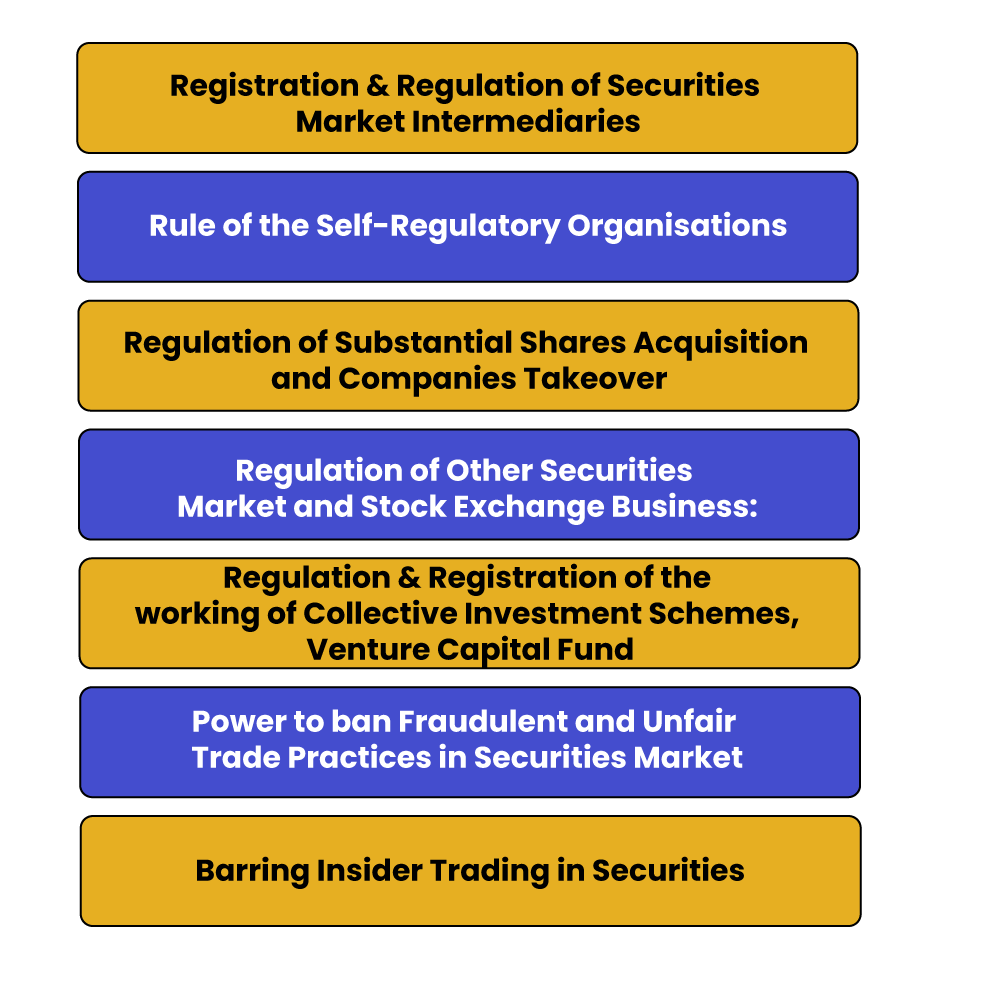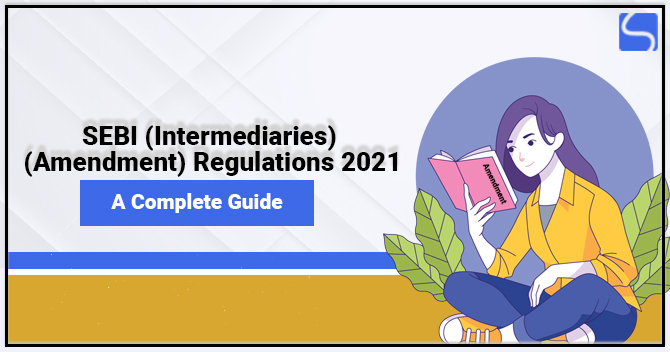A Complete Overview on the Powers of SEBI

Karan Singh | Updated: Sep 13, 2021 | Category: SEBI Advisory
SEBI (Securities and Exchange Board of India) came into existence on 30th January 1992 as a legal authority under a regulation. The regulation was consented by both Parliament houses on 1st April 1992; however, the regulation is said to have come into existence from the date when the ordinance was issued. In this blog, we will discuss the powers of SEBI.
Table of Contents
What is SEBI?
Before we discuss the powers of SEBI, let’s discuss the meaning of SEBI in India. SEBI is a legal body of the Government of India that was established in April 1992. SEBI was introduced to boost transparency in the Indian Investment Market. Moreover, its headquarters in Mumbai, the establishment has various regional offices across the country, comprising Ahmedabad, Chennai, New Delhi, and Kolkata.
It is entrusted with the task to control the working of the Indian Capital Market. The regulatory body sets focus on monitoring and regulating the securities market in India to protect the investors’ interest and intend to inculcate a safe investment environment by executing different rules & regulations and by formulating investment-related guidelines.
In India, SEBI follows a corporate structure. It has BoDs (Board of Directors), senior management, department head & several crucial departments. To be precise, it includes more than 20 departments, all of which are observed by their relevant departments’ heads, which in turn are regulated by a hierarchy in general.
The hierarchical structure of the Securities and Exchange Board of India includes the following designated officers:
- One member belonging to the RBI;
- Two members belonging to the UFM (Union Finance Ministry) of India;
- The Chairman nominated by the Union Government of India;
- The other 5 members were appointed by the Union Government.
Following is the list of some most vital departments of SEBI in India:
- The IT Department;
- International Affairs Office;
- HR Department;
- The Foreign Portfolio Investors & Custodians;
- National Institute of Securities Market;
- Department of Investment Management;
- Commodity & Derivative Market Regulation Department.
Powers of SEBI in India
SEBI has various powers to fulfil the purposes of the SEBI Act, 1992. Securities and Exchange Board of India can take preventive action & disciplinary actions to safeguard the investors & encourage the securities market. Such measures can be in the form of circulars, press releases, etc. Moreover, the measures can also be taken if it is exercised in maintenance & consonance of the specified objectives. Following are the powers of SEBI:

- Registration & Regulation of Securities Market Intermediaries: Securities and Exchange Board of India has the power to issue regulations or rules for Registration & can deliver for the eligibility criteria, rules for capital adequacy, code of conduct tec. Unless the Registration Certificate is provided by the Securities and Exchange Board of India, no individual can involve in activities that a SEBI registered mediator undertakes.
- Rule of the Self-Regulatory Organisations: These organisations are given the responsibilities of being the 1st level regulator for a segment of mediators in the securities market being its members. SEBI issued recognitions to self-regulatory organisations & looks after the activities of such organisations, and help them in maintaining ethical benchmarks. It aids in maintaining accountability, fairness, and transparency to investors.
- Regulation of Substantial Shares Acquisition and Companies Takeover: SEBI mandates open offer & needs disclosure to be made by the acquirer and the person acting in concert with such acquirer. It offers who would be an acquirer, Target Company, etc. What it does is makes sure the Takeover process is transparent and fair. SEBI also mandates enough disclosures from the promoters & acquirers of the listed companies. Among the powers of SEBI, it can make regulations under Section 30(2) of the SEBI Act. Regulations have been offered for securities market intermediaries, AIF (Alternative Investment Funds), Foreign Portfolio Investors (FPI), mutual funds, insider trading, takeovers and matters concerning securities matters. But, it may be noted that rules if SEBI is governmental in nature and legal in character.
- Regulation of Other Securities Market and Stock Exchange Business: Securities and Exchange Board of India concentrates on maintaining integrity, clarity, and proper working of the stock exchanges via different methods such as Broker Registration, addressing investor complaints, rising trading hours, etc. Securities and Exchange Board of India also has the power under Securities Contract (Regulation) Act, 1956 to grant identification to stock exchanges, supersede business of stock exchange, withdrawal of acknowledgement, etc. These powers have been delegated by the Central Government of India.
- Regulation & Registration of the working of Collective Investment Schemes, Venture Capital Fund: Previously, the Mutual Funds were regulated by the RBI (Reserve Bank of India) guidelines, which was appropriate to Mutual Funds supported by Banks. Securities and Exchange Board of India gives Registration Certificate to the Mutual Fund. It also regulates the structure & the constitution of the fund, its AMCs, Trust Deed Registration and has the power to control various schemes and businesses of mutual funds.
- Power to ban Fraudulent and Unfair Trade Practices in Securities Market: Securities and Exchange Board of India informed the SEBI (Prohibition of Fraudulent & Unfair Trade Relating to Securities Market) Regulations 2003. Fake transactions & unfair trade practices recognised by SEBI comprise price rigging, circular trading, inflating, variable securities price, publishing any false statement or misguiding advertisement, among others.
- Barring Insider Trading in Securities: Securities and Exchange Board of India has taken measures for barring Insider Trading by the participants in the securities market. Securities and Exchange Board of India framed the 1st Prohibition of Insider Trading Regulations in the year 1992, after that replaced it with the Prohibition of Insider Trading Regulations, 2015, furnishing for the insider meaning, unpublished price sensitive details, trading, etc. Securities and Exchange Board of India establish various committees with a purpose of strengthening the market integrity and to boost the confidence of investor.
Analysing Powers of SEBI
Quasi-judicial functions of the Securities and Exchange Board of India and its ruling are subject to appeal, and the responsibilities of the Securities and Exchange Board of India fall to the other side in the case of the doctrine of power separation. The Board uses its legislative powers y making rules & regulations, executive powers by administering regulations made by it and taking some measures against the company that breaks the rules and legal power by adjudication clashes in the execution. Such power should obey the constitution and the SEBI Act and shouldn’t contradict it.
The SEBI has the power to order for investigation if it has a reason to believe that a transaction in securities is harmful to the securities market or investors or if anyone infringes the provisions of the Act. Securities and Exchange Board of India also has the control of a civil court where it can summon and order for the person’s presence, inspect them, and examine books of accounts.
Moreover, as a part of the powers of SEBI, it can contain an individual or ban a person from accessing the securities market. Such order or decision can be made by the Securities and Exchange Board of India even on the suspense of investigation. Further, the SEBI (Securities and Exchange Board of India) can recover illegal gains made by an individual via unauthorised conduct by issuing a disgorgement order.
Securities and Exchange Board of India can also take actions on unauthorised schemes introduced by entities to make money from retail investors, refrain an individual acting as mediator like Investment Advisor, Research Analyst, etc., not to solicit or undertake an activity in securities either indirectly/directly.
What are the Functions of SEBI?
After discussing the powers of SEBI, let’s discuss the functions of SEBI. SEBI[1] has three different functions:
- Regulatory Functions: The intention behind executing these functions is to keep a check on the business of the financial markets work function. These functions shall comprise:
- Conduct the audit of inquiries and exchanges;
- Fee levying;
- Practising powers & implementing powers;
- Regulate the companies takeover;
- Registration of Merchant Bankers, brokers, etc.;
- Register & regulate the Credit rating Agency;
- Framing the Code of Conduct & guidelines for the proper role of the financial intermediaries.
- Development Functions: These functions are performed by the Securities and Exchange Board of India comprises but are not limited to:
- Encourage fair trading & decrease malpractices;
- Support of the self-operating enterprises;
- Selling & buying of Mutual Funds from Asset Management Company through a broker;
- Assigning training to mediators;
- Carrying of the research work;
- Protective Functions: These functions are laid out by the Securities and Exchange Board of India to safeguard the interest of investors and other financial participants like encouraging fair practices, check price rigging, to create consciousness among the investors & ban fake activities & unfair trade practices.
Powers of SEBI with Respect to Mutual Funds Regulations
Following are some regulations for Mutual Funds laid down by SEBI:
- ASM (Asset Management Company) cannot have the depiction on a board of any other mutual hand;
- The complete weight of the top 3 constituents of the index cannot be more than 65%;
- Investors of liquid schemes who exit the scheme within seven days need to pay the penalty for exit;
- Any group company or entity which comprises the AMC of a fund cannot hold 10% or more of the voter rights and shareholding in the Asset Management Company;
- The new funds must submit their compliance status to the Securities and Exchange Board of India before it is getting launched;
- The limit of all stocks is limited to 25% for all the indices except the index for a thematic/sectoral index. The cap cannot be more than 35% of these indexes.
Securities Appellate Tribunal
Every SEBI’s order is appealable under Section 15T to Securities Appellate Tribunal. Securities Appellate Tribunal is a professional body. It can exercise its discretionary jurisdiction in a similar manner as SEBI. Any order by SAT can be enforced in a similar way as if it was a decree done by a Civil Court in a suit before it. The Tribunal may send it for implementation to the Court within the local limits of whose jurisdiction the incorporated office of the company is located in case the order is against the company or where the individual or a person voluntarily resides or carries on business, in the case is against any individual.
An aggrieved person can appeal to the Supreme Court under Regulation 15Z only a law question arising out of any decision of Securities Appellate Tribunal. Remember that even though a right of appeal to the Supreme Court is offered, a writ petition under Article 226 to High Court or under Article 32 to Supreme Court against the SAT order continues to be maintainable, invoking for applying the fundamental rights.
Conclusion
The powers of SEBI have been elevated time & again by the Indian Parliament; this is because its role in the Financial System of India is crucial. It is secure to say that SEBI (Securities and Exchange Board of India) is one of the most substantial regulatory bodies in India. It has an immense role in avoiding huge financial scams or frauds by regulating the Indian Financial Market via its 20 departments.
Read our article:Investigation Under Section 11C of the SEBI Act – An Overview














